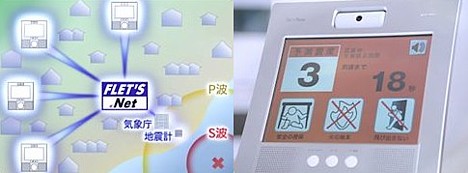
NTT is developing a device that provides advance warning of earthquakes seconds before they strike by relying on data from a nationwide system of seismometers put in place by the Japan Meteorological Agency. The sensors detect an earthquake's primary waves ("P-waves"), which travel more quickly and are much weaker than the lower-velocity secondary waves ("S-waves") that cause the major damage associated with earthquakes.
When the sensors detect P-waves, data about the timing and strength of the coming S-waves is instantly delivered to the earthquake alarms via NTT's fiber optic network, notifying the users in their homes before the S-waves strike. The time difference between the arrival of P-waves and S-waves depends on the distance from the epicenter, so locations farther from the epicenter can receive warnings much more in advance than those near the epicenter. Unfortunately, people located directly above the epicenter, where the earthquake is at its strongest, are unlikely to receive any advance warning at all.
The TV commercial for the device (as well as the extended web version, now on YouTube) shows a mildly touching dramatization of the device at work.
The commercial focuses on a female college student who is majoring in home economics and living at home with her parents. When home alone, the girl spends most of her free time in the kitchen honing her cooking skills by preparing dishes like goya kinoko champuru, an Okinawan stir-fry made with bitter gourd, mushroom and eggs. The kitchen is equipped with an NTT earthquake alarm.
The first time the earthquake alarm sounds, the girl goes into a mild panic, squandering her 20-second warning by wondering where to set the dish she is holding. She finally crawls under the dining table and all is well.
The next time an earthquake comes, she is prepared. The alarm sounds and the mechanical voice informs her that a magnitude 3 earthquake will strike in 20 seconds. As the countdown begins, she calmly turns off the stove, opens the patio doors, and crawls under the table. The voice instructs her to protect herself from physical harm until the shaking stops, advising her not to run outside in a panic. The voice then instructs her to make sure the gas is turned off and evacuate to a safe place once the quake has passed. Finally, the voice instructs her to pay attention to the information provided by the mass media and the local authorities, again reminding her to remain calm.
Later, the girl's mother calls to check on her. Having cooked a great deal of food, the girl tells her mother to come home hungry. Later they will feast.
Luckily for all, the earthquake was only a magnitude 3 affair, unlike the monster that struck Kobe back in 1995.
I have fortunately never seen the need to duck and cover during an earthquake and I don't know how well I would fit under my dining table, but nonetheless it would be nice to have a 20-second warning before the Big One hits.
[Further reading: Asahi Shimbun (English)]

Yubi
;-)
[]she might not be fast in "hiding" ... but very fast in changing clothes
;-)
Martijn
Pretty faces like that should deffinatly be warned before an earthquake!
[]Miguel Burgos
I want the product how I can get it?
[]What is the price?
Saumik
Video not available.please post another one.
[]